David Suzuki's Blog, page 19
January 12, 2017
We can learn so much from nature
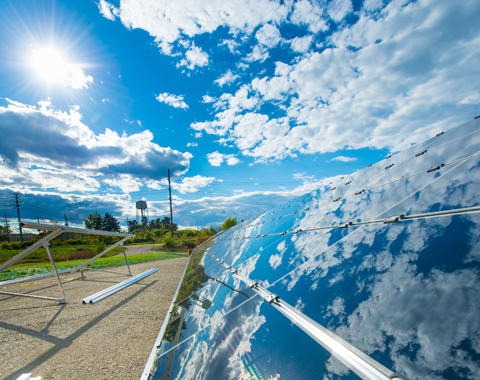
(Credit: Argonne National Laboratory via Flickr)
If you fly over a forest and look down, you'll see every green tree and plant reaching to the heavens to absorb the ultimate energy source: sunlight. What a contrast when you look down on a city or town with its naked roofs, asphalt roads and concrete sidewalks, all ignoring the sun's beneficence! Research shows we might benefit by thinking more like a forest.
Solar roads could be a step in that direction. Roads, sidewalks and parking lots cover massive areas. Using them to generate power means less environmental disturbance, as no new land is needed to house solar power operations.
A French company, Colas, is working with the French National Institute for Solar Energy to test its Wattway technology under various conditions, with a goal of covering 1,000 kilometres of existing highway with thin, durable, skid-resistant crystalline silicon solar panel surfacing over the next four years. They estimate that could provide electricity for five million people. Although critics have raised questions about cost and feasibility, it's not pie-in-the-sky. The technology is being tested and employed throughout the world.
Rooftops are another place to generate power using existing infrastructure. Elon Musk's company Tesla is making shingles that double as solar panels. Although they cost more than conventional asphalt shingles, they're comparable in price to higher-end roof tiles, and can save money when you factor in the power they generate.
These developing technologies show that, as the world continues to warm, we can and must move beyond our outdated ways. In Canada and elsewhere, the political approach to climate change has often been to avoid discussing it -- in part by firing government scientists or vetting their public statements -- and maintaining the status quo by lavishly supporting unproven and risky technologies like carbon capture and storage that keep us tied to fossil fuels for years to come. It's nonsensical to dig up and melt oilsands bitumen, transport and burn it, and attempt to capture the emissions and stick them back in the ground, where nature had already stored the carbon. Nature took millions of years to do it, but we aren't a patient animal.
U.S. science writer Janine Benyus coined the term "biomimicry" to describe technologies based on nature's ability to solve problems or exploit opportunities. It's an important concept because it requires humility and respect for natural processes rather than the imposition of our crude but powerful technological innovations.
Every species shares the same challenges: how to get energy and food, avoid predators and disease (even bacteria get viral infections), what to do with waste and how to reproduce. Over long periods, numerous strategies to solve these challenges have evolved. We are a species magnificently adapted for survival, with a massive brain relative to our body size. Unlike any other species, we have the ability to ask questions and seek answers. We can find a treasure trove of solutions in the ways other species have dealt with challenges.
Biomimicry has inspired applications ranging from producing energy through artificial photosynthesis to building lightweight support structures based on the properties of bamboo.
By learning how nature works and how to work within it, we can overcome many problems we've created by trying to jam our technologies on top of natural systems. Fossil fuels were formed when plants absorbed and converted sunlight through photosynthesis hundreds of millions of years ago, then retained that energy when they died, decayed and became compacted and buried deep in the Earth, along with the animals that ate them. Rapidly burning limited supplies of them is absurd, especially when they can be useful for so many other known and possibly yet undiscovered purposes.
Surely, with our knowledge and wisdom we can do better than rely on the primitive idea of burning things to stay warm and comfortable without regard for the consequences -- pollution of air, water and land with its related impacts on health, as well as climate change, which is putting humanity's survival at risk.
Our economic systems don't often encourage the most efficient and least harmful ways of providing necessities. They aim for the quickest, easiest, cheapest and most economically profitable paths. We can do better than that. Harnessing the sun's power and learning how nature solves challenges are good places to start.
Hey! Want more DSF? Join David Suzuki on Facebook

January 11, 2017
World-class seabird habitat deserves world-class protection

(Tufted Puffins, credit: Martha de Jong-Lantink)
Tell the federal government to strengthen proposed protections for the marine area surrounding the Scott Islands.
Hey! Want more DSF? Join David Suzuki on Facebook

January 5, 2017
It's time to heed warnings about humanity's collision course
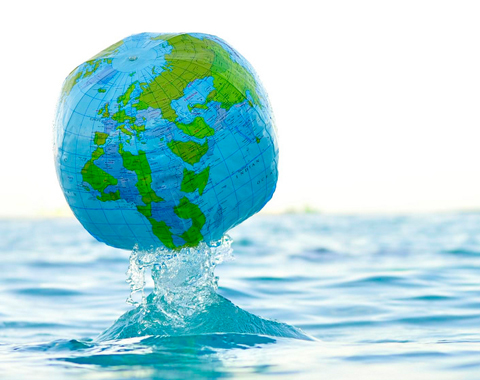
(Credit: Nattu via Flickr)
The longer we delay addressing environmental problems, the more difficult it will be to resolve them. Although we've known about climate change and its potential impacts for a long time, and we're seeing those impacts worsen daily, our political representatives are still approving and promoting fossil fuel infrastructure as if we had all the time in the world to slow global warming.
We can't say we weren't warned. In 1992, a majority of living Nobel prize-winners and more than 1,700 leading scientists worldwide signed a remarkable document called "World Scientists' Warning to Humanity".
It begins, "Human beings and the natural world are on a collision course. Human activities inflict harsh and often irreversible damage on the environment and on critical resources. If not checked, many of our current practices put at serious risk the future that we wish for human society and the plant and animal kingdoms, and may so alter the living world that we will be unable to sustain life in the manner that we know. Fundamental changes are urgent if we are to avoid the collision our present course will bring about."
It then outlines critical areas where the collision was and is still occurring: the atmosphere, water resources, oceans, soil, forests, species extinction and overpopulation. In the 25 years since it was published, the problems have worsened.
The document grows bleak: "No more than one or a few decades remain before the chance to avert the threats we now confront will be lost and the prospects for humanity immeasurably diminished. We the undersigned, senior members of the world's scientific community, hereby warn all humanity of what lies ahead. A great change in our stewardship of the earth and life on it is required, if vast human misery is to be avoided and our global home on this planet is not to be irretrievably mutilated."
Now, as monthly and annual records for rising global average temperatures continue to break, as extreme weather events become more frequent and severe, as refugees overwhelm the capacity of nations, and as tipping points for climatic feedback loops and other phenomena are breached, the need to act is more urgent than ever.
The warning suggests five steps needed immediately. That was a generation ago. They can still help prevent the worst impacts:
"We must bring environmentally damaging activities under control to restore and protect the integrity of the earth's systems we depend on." It specifically mentions reducing greenhouse gas emissions and air and water pollution. It also highlights the need to address deforestation, degradation and loss of agricultural soils and extinction of plant and animal species.
"We must manage resources crucial to human welfare more effectively." This one is obvious. Finite resources must be exploited much more efficiently or we'll run out.
"We must stabilize population. This will be possible only if all nations recognize that it requires improved social and economic conditions, and the adoption of effective, voluntary family planning."
"We must reduce and eventually eliminate poverty."
"We must ensure sexual equality, and guarantee women control over their own reproductive decisions."
The warning recognizes that we in the developed world are responsible for most global pollution and therefore must greatly reduce overconsumption while providing technical and financial aid to developing countries. This is not altruism but self-interest, because all of us share the same biosphere. Developing nations must realize environmental degradation is the greatest threat to their future, while rich nations must help them follow a different development path. The most urgent suggestion is to develop a new ethic that encompasses our responsibility to ourselves and nature and that recognizes our dependence on Earth and its natural systems for all we need.
The document ends with a call for support from scientists, business and industrial leaders, religious heads and all the world's peoples. Like Pope Francis's groundbreaking 2015 encyclical, "Laudato Si", the "World Scientists' Warning to Humanity" was an attempt to galvanize the world to recognize the dangerous implications of humanity's path and the urgent need for change.
Forewarned is forearmed. We can't let the lure of the almighty buck blind us. We must come together, speak up and act for the good of all humanity.
Hey! Want more DSF? Join David Suzuki on Facebook

Asbestos ban is a victory for health but leaves a painful legacy
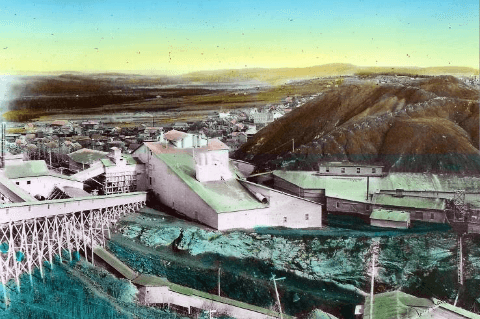
Asbestos mine industry (Crédit: Musée McCord/Wikimedia Commons)
One of the most celebrated films in the history of French-Canadian cinema, Mon oncle Antoine, opens with shots of an asbestos mine in Black Lake (now Thetford Mines) in the 1940s. Beginning in the late 19th century, the Thetford Mines and asbestos regions of Quebec progressed and grew richer thanks to this group of minerals, the health risks of which were little understood at the time. The heat-resistant properties of asbestos made it useful for many industrial applications, including brake pads, handles for pots and pans and residential construction, among others. As the years went by, asbestos was everywhere. It was used domestically and exported. It surrounded us, like a bear hug leading to a slow death.
A whole slice of the history of Quebec and the rest of Canada is framed by the rise and fall of asbestos mining. Today, we know beyond all doubt that this substance is linked to fatal illnesses.
In mid-December 2016, federal Health Minister Jane Philpott spoke in no uncertain terms: "Breathing in airborne asbestos fibres can cause serious health problems, including lung cancer. Exposure to asbestos can also lead to mesothelioma, a rare but aggressive form of cancer with a poor prognosis."
Exposure over many years by asbestos industry workers and family members who were indirectly exposed at home, as well as the larger population, has left us with a painful heritage that we will regret for a long time. In early 2016, a Canadian Press report painted a grim picture of mortality, both in the past and to come, caused by asbestos exposure: "In 2012, there were 560 new cases of mesothelioma, up from 276 cases recorded in 1992, the Statscan website shows. Between 2000 and 2012...deaths from the asbestos-related malignancy jumped 60 per cent -- to 467 from 292."
The World Health Organization has been warning of this product's dangers for 30 years. Seen in that light, the recent decision by the federal government to ban the use, import and export of asbestos by 2018 is long overdue.
That decision is a step in the right direction, and one that several health specialists and environmental groups -- the David Suzuki Foundation among them -- have been demanding for a long time.
In September 2012, David Suzuki Foundation Quebec director Karel Mayrand wrote, "We still have a long way to go to make sure asbestos stays in the ground and no longer poses a threat to human health. Remember, asbestos kills 90,000 people in the world every year: that's the equivalent of one Hiroshima per year, for generations. The death toll must be stopped. Quebec and Ottawa must act to ban the extraction and exporting of asbestos."
Petitions were circulated, and voices were raised -- including yours. You have spoken out against this industry that has been slowly killing us, and now you have won.
Asbestos will still be present in many buildings, infrastructure and products, posing a variety of challenges for property managers, among others, who must take inventory of and secure, at considerable expense, even the slightest repair job in an affected area. To simply drive a nail into an office wall to hang a picture, if the gypsum board is contaminated, a workplace health and safety team must be called in! Decontaminating sites will take a long time, and will cost a lot of money. But it is the right thing to do and it must be done. Unfortunately, asbestos will continue to be mined in countries that have decided to ignore science and put profits before lives. Russia, for example, has taken over from Canada as a leading irresponsible exploiter of the resource. On a global level, the battle against asbestos is far from over.
Here at the Foundation, our thoughts and our voices of solidarity are with the victims, both past and future, and their families.
To all of you, this is our pledge: We will continue our fight to ensure that science and the precautionary principle light our way, serving as the sole foundation for decisions that affect the environment and indeed our very existence.
Hey! Want more DSF? Join David Suzuki on Facebook

December 16, 2016
It's time to ban bee-killing pesticides
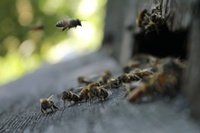
Federal and provincial governments share responsibility for pesticide regulation in Canada. Join us in calling on our regulators to side with the science and ban neonics.
Hey! Want more DSF? Join David Suzuki on Facebook

December 15, 2016
Tread lightly to lift the weight of the world
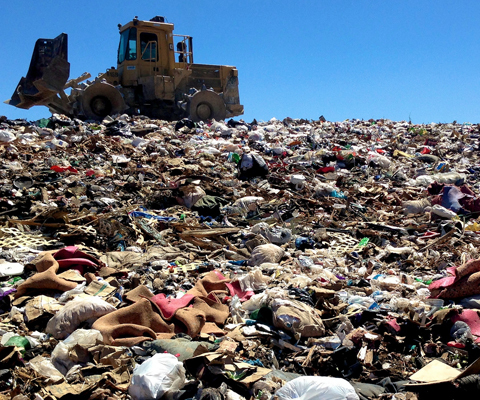
(Credit: Alan Levine via Flickr)
How much stuff will you give and receive this holiday season? Add it to the growing pile -- the 30-trillion-tonne pile. That's how much technology and goods humans have produced, according to a study by an international team led by England's University of Leicester. It adds up to more than all living matter on the planet, estimated at around four trillion tonnes.
Scientists have dubbed these times the "Anthropocene", because humans are now the dominant factor influencing Earth's natural systems, from climate to the carbon and hydrologic cycles. Now they're labelling our accumulated goods and technologies -- including houses, factories, cars, roads, smartphones, computers and landfills -- the "technosphere" because it's as large and significant as the biosphere, atmosphere and hydrosphere. Researchers estimate it represents 50 kilograms for every square metre of Earth's surface and is 100,000 times greater than the human biomass it supports.
As CBC science commentator Bob McDonald wrote, "Our technology is a super-organism that competes with the biosphere for resources, and is winning that competition by taking over the surface of the planet."
Report co-author Mark Williams explained the significance: "The technosphere can be said to have budded off the biosphere and arguably is now at least partly parasitic on it. At its current scale the technosphere is a major new phenomenon of this planet -- and one that is evolving extraordinarily rapidly. Compared with the biosphere, though, it is remarkably poor at recycling its own materials, as our burgeoning landfill sites show. This might be a barrier to its further success -- or halt it altogether."
Living systems renew and recycle. Organisms die, get eaten or absorbed by other organisms, and other life takes their place. But much of what we produce takes enormous amounts of natural, mostly finite resources to make and breaks down slowly, if at all. It covers the land and fills oceans, and even extends into space. As the human population continues to grow and consumerism shows no signs of abating, the technosphere expands, causing pollution, contamination and resource depletion, further upsetting the delicate natural balance that keeps our planet habitable for humans and other life forms.
Many things we've invented have made our lives easier in some ways. But much is unnecessary and, we've learned, a lot comes with consequences we didn't foresee -- such as climate-altering greenhouse gas emissions from our obsession with private automobiles and cheap energy.
If this pace continues, we'll leave a fascinating fossil record for any intelligent species that comes across our planet in the future. But that may be all. If we want to survive as a species, we must get a handle on population growth and consumerism. It's something to consider this time of year, when so much time and energy are spent on acquiring new stuff, for ourselves and others.
Although population growth is starting to stabilize, curtailing growth requires greater access to effective, voluntary family planning and birth control, increased women's rights including the right to make decisions about their bodies and reproduction, and reducing poverty.
We can all do our part to reduce consumption. We might find we're happier when we do. At the end of his life, my father didn't talk about accomplishments or possessions or wealth. He talked about connections to friends and family and shared experiences. Although he didn't have a lot of material possessions, he felt wealthy and happy.
That's what life is about. A new car or smartphone won't make you happier in the long run. Nor will it fill gaps caused by loneliness or lack of connection to others. That doesn't mean we should live without material goods, but we should consider what we really need, and make sure we recycle items we can no longer use. Reduce, re-use and recycle! And reconsider what really makes us happy.
More important, during the holiday season, we should nurture our connections to friends and family, and give gifts that won't add to the technosphere. We can share time, experiences and food. Those who find themselves alone might consider volunteering to help others during what can be a difficult time.
May you all have a joyous season, focused on the important things in life. And may the New Year bring humanity a greater understanding of what truly makes life worthwhile.
Hey! Want more DSF? Join David Suzuki on Facebook

December 14, 2016
Breaking down Canada's long-awaited climate action plan
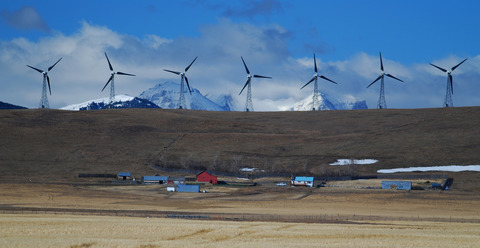
(Credit: Gord McKenna via Flickr)
This past year has had highs and lows for climate action.
Before Canadians head off to enjoy eggnog and holiday cheer, we wanted to provide some additional context to the federal climate action plan (the Pan-Canadian Framework on Clean Growth and Climate Change) released on December 9 in Ottawa.
This is a major milestone in Canada's history. For the first time, Canada has built the foundation of an effective national climate plan that, if fully implemented, would put the country within striking distance of meeting our 2030 greenhouse gas target. This is a huge step for Canada's response to climate change, but our country must strive to do better.
Why? First, we have the weakest 2030 emissions target of any G7 country, and the national plan is still shy of meeting Canada's Paris commitment. In addition, recent pipeline approvals threaten to slow progress. Clearly, more effort is needed in 2017. But, despite the shortcomings, it is worth celebrating this milestone. This achievement is the result of millions of Canadians making their voices heard in Ottawa.
As for solutions the David Suzuki Foundation and our supporters have been advocating, the federal framework delivered on many policies we put forth, including:
An increasing price on carbon pollution that will encourage innovation and deployment of clean energy.
A phase-out of coal-fired power and ramp-up of clean, renewable energy.
A clean-fuel standard that will cut emissions from transportation fuels.
Big infrastructure investments: A $47.2 billion, 11-year investment commitment to transit, electric vehicles and renewable energy infrastructure, and ecosystems that counteract the impacts of climate change. We will evaluate the progress toward these commitments in the upcoming federal budget.
A requirement to cut methane emissions from the oil and gas sector.
A green-building standard that will improve energy efficiency of homes and buildings.
A clean technology strategy, green government procurement, and solutions for waste and agriculture.
A review mechanism to hold parties accountable for implementing the plan.
Positive things that fall short:
The framework acknowledges the importance of the United Nations Declaration on the Rights of Indigenous Peoples (UNDRIP) and Indigenous traditional knowledge. However, fossil fuel infrastructure projects have recently been approved despite flawed processes and opposition from numerous Indigenous groups.
The framework includes a ratcheting tool that could increase the ambition of our emissions reduction target, but it is not guaranteed.
The plan calls for the elimination of fossil fuel subsidies by 2025 but fails to outline scheduled decreases that could be made in the near term.
Problems:
Approvals of long-lived carbon infrastructure projects such as the Kinder Morgan and Line 3 pipelines and Pacific NorthWest LNG project that, if built, will contribute to increased emissions from the oil and gas sector, acting against Canada's ability to uphold its Paris climate commitment.
The plan is missing a zero-emission vehicle standard to increase the availability and share of low- and zero-emission cars. However, the federal government has set a 2018 timeline to develop an electric vehicle strategy.
Following a year of political turmoil around the world, it is nice to end on what is generally a positive note in Canada. Together we have made significant progress this year while renewable technologies have continued to become more efficient and affordable.
Our work will continue in 2017 as we advocate for a clean, sustainable future for Canada. Solutions to put Canada on that course exist. We look forward to having you along with us.
Onward!
Hey! Want more DSF? Join David Suzuki on Facebook

David Isaac: A leader in First Nations solar energy
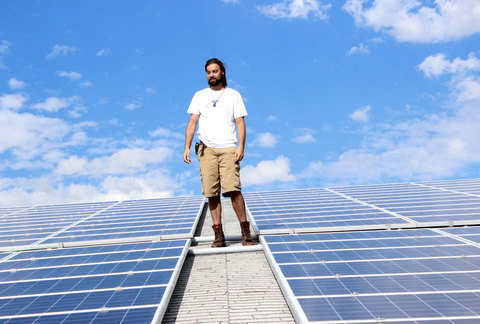
Credit: Thomas Giwusk Isaac-Came
David Isaac, an Ottawa-born renewable energy developer whose ancestry is Mi'kmaq, tells me the English translation of his company's name, "W Dusk", is "northern lights". The moniker is appropriate.
Isaac has spent the past several years capturing sunlight with the solar power arrays he designs and builds in First Nations communities across British Columbia and Alberta. And just as the aurora borealis is intensely beautiful, Isaac works to ensure his installations are visually arresting. He recently placed 330 solar panels on a school run by the Lower Nicola Indian Band in Merritt, B.C., a three-hour drive from Vancouver. He says the building "really vibrates."
Last year he created a solar system with the Lubicon Lake Band in their oilsands-affected community of Little Buffalo, Alberta. It features 80 photovoltaic panels on steel poles an impressive eight metres high. "I wanted something inspiring," he says. "If you can beautify drab settings, there are positive outcomes like [mental] health and community success." In 2017, he'll mount a solar system on a museum in the Haida Gwaii community of Skidegate, B.C. The project's battery bank will be housed in a Haida sculpture built of locally sourced cedar. "Solar arrays need to be aesthetically pleasing," he explains. His strategy is wise: Opponents of Ontario wind turbines often criticized the structures for being unsightly.
Attentive to his work's artistic merit, the University of Victoria-trained Isaac -- who originally planned to study medicine -- is also pragmatic. The Lower Nicola project, B.C.'s largest community solar system, will eventually provide the local school with about half its power. It will reduce the band's electricity bill and, through cost-savings, provide funds for scholarships. Isaac is pleased it took only three weeks to build.
His philosophy is, "The community owns the project." But ownership is not merely financial. Local residents -- some of whom are hired to build racking and install panels -- often feel a personal connection and pride. "This is the first time in history that First Nations can lead an emerging sector," Isaac says. "Solar arrays are the technological embodiment of the community's values."
Those values include energy independence, fiscal responsibility and environmental protection. The Skidegate project, for example, will significantly lower the community's electricity costs while allowing it to reduce reliance on dirty diesel-powered generation.
Little Buffalo is Isaac's most hopeful project. It's situated in Lubicon territory near a wetland that suffered a 2011 pipeline spill of some 28,000 barrels of crude -- "one of the largest oil spills in Alberta history", according to Amnesty International. But the president of W Dusk says the solar array, which powers the local health centre, has "changed the complexion of the community", beautifying it and bringing a measure of optimism. No wonder. The Pembina Institute rates Alberta's solar resources as "among the best" in Canada.
"The oil patch," concludes Isaac, "is becoming the solar patch."
Hey! Want more DSF? Join David Suzuki on Facebook

Christmas trees 2.0: Toward truly ecological natural trees!
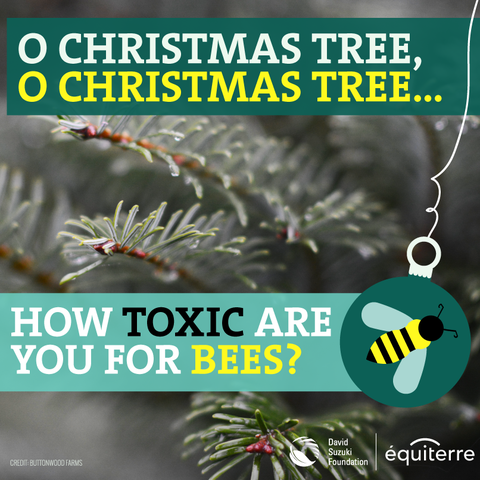
Natural versus artificial: Which is greenest?
If you answered natural, congratulate yourself. A local natural tree is more ecologically friendly than an artificial tree, unless you keep the artificial one for more than 20 years, according to a 2009 Quebec study. This life-cycle analysis compared a spruce tree growing 150 kilometres from Montreal to a plastic tree imported from China. Greenhouse gas emissions and raw materials were the main determinants of this conclusion. Artificial trees can also release volatile chemicals called phthalates, which disrupt our hormones (endocrine disruptors).
Despite this environmental edge, natural Christmas trees may be risky for ecosystems. To protect trees from pests and to limit competition with herbaceous plants, many tree farms use pesticides.
Protecting pine trees from pests: Is it really necessary?
The number one enemy of the balsam fir, a tree well-known for its fragrance, is an aphid that attacks the buds and causes deformation of needles. If you choose a Fraser fir, the buds do not hatch at the time the aphids are most damaging, so it requires less insecticide.
The year 2016 marked the end of use of an effective but toxic insecticide, diazinon. Among alternative products registered for use on Christmas trees in Canada is imidacloprid. It belongs to the family of neonicotinoids or "neonics", which have been linked to declines of bee populations. Beyond their impacts on pollinators, neonics carry several other risks, notably for aquatic insects that are the basis of several ecosystems and for earthworms that are engineers of our soil. They are relatively persistent in the environment and result in widespread contamination of surface waters and are even sometimes detected in groundwater in agricultural areas. Unless public consultations lead to a change of plan, Health Canada is planning to ban it within three to five years.
The search for less toxic alternatives is in full swing in Quebec. For at least 15 years, we have learned more about pests. A Phytosanitary Warning Network producers when pest populations become a concern in a region, and agronomists regularly screen plantations. Thus, insecticide applications are no longer systematic and routine, but are rationalized according to the risks of damage to fir trees.
At Quinn Farm, near Montreal, no insecticide treatment was required in 2016, and only one was used the previous year. The farm has beehives in its plantation, so they take great to reduce use of pesticides that could harm bees.
To find out if your tree has been produced in an environmentally friendly way, ask growers if they are practising integrated pest management, suggests biologist François Gendron of the Estrie Agri-Environmental Club.
Limit competition in plantations
To maximize tree growth, controlling herbaceous vegetation under the trees should also be carried out. While some growers remove vegetation over the entire plantation, most retain vegetation cover between rows. These plants minimize fertilizer runoff, stabilize the soil and support pollinators and insects that control pest populations.
Herbicides, such as those formulated with glyphosate, are common weed killers because they are inexpensive and easy to use, but they pose a number of environmental and human health risks. Some producers have abandoned herbicides and instead use mechanical mowing. In well-aligned plantations with well-spaced rows, it is easy to use a lawnmower. To avoid damaging young tree trunks, some producers use precision weeding guided by infrared cameras.
At Quinn Farm near Montreal and in another organic farm in France, an idea that seemed far-fetched was adopted. They let sheep graze in the plantation! Since then, they no longer need herbicides. "They do a good job," Philippe Quinn says.
**Do organic Christmas trees exist?
**
Organic production does not use the most toxic synthetic pesticides. No Christmas tree producer is certified organic in Canada, where the current standards concern mainly food, according to Jérôme-Antoine Brunelle, coordinator for organic agriculture development at the Union of Agricultural Producers. Its association would look positively at widening the spectrum of this standard in the country.
Without standards or verifications, you will have to trust producers if they tell you they grow organically, but some market themselves as such. In particular, close to Rouyn-Noranda in northern Quebec, producer Jacquelin Thibault of Tibo farm uses no synthetic input. "Why use fertilizers that make the hay grow so tall that it must then be constantly mowed?'' he asks. He simply lets nature do its job. And to fight insect pests? "They do not like it here; it's way too cold," he says laughing. He praises his fresh cut pines that do not lose their needles and have a natural shape. If organic pine trees can take two extra growth years to reach the conventional size of about two metres, the wait does not appear to hurt his business, claims the owner of 10,000 trees.
According to Jimmy Downey of the Quebec Christmas Tree Producers' Association, organic production in Quebec would significantly increase production costs, which could limit demand. In France, a producer of organic trees maintains that their trees sell at the same price as conventional ones. They save on agro-chemical inputs but have higher labour costs. The Buttonwood farm near Seattle on the West Coast maintains that demand is strong for their new product.
**In brief ...
**
There are several organic Christmas tree producers in the U.S., but they account for less than one per cent of domestic sales. Quebec is the largest Canadian producer and exports its trees mainly to the U.S. market. Natural Christmas tree production support whole villages, according to Émilie Turcotte-Côté, agronomist at the Estrie Agri-Environmental Club.
Our trees are becoming more environmentally friendly, but there is a need for increased investment in research and development. In the meantime, ask your producers the right questions and encourage good practices.
For those who still have an artificial tree, the most ecological choice is to keep it as long as possible, because it will last hundreds of years in a landfill!
Hey! Want more DSF? Join David Suzuki on Facebook

December 12, 2016
Twelve ways to green your holidays

Give the gift of time, it's precious. AND it's something you never get back (or have to dust, recycle or regift next year). (Credit: Nancy Lees)
'Tis the season of overconsumption and all its consequences -- intended and unintended.
Here's a "best of" my holiday blogs to help get you through:
Tip 1: You have at least six options for holiday trees. Some you can plant to start a Christmas tree forest!
Tip 2: Ask for "presence" instead of "presents" from friends and family. Giving the gift of time is precious. AND it's something you never get back (or have to dust, recycle or regift next year).
Tip 3: Follow regifting etiquette 101.
Tip 4: Need a teacher gift idea? Make organic, fair trade shea butter lip balm with ingredients safe enough to eat!
Tip 5: Who needs gift wrap? Forego paper, scissors and tape! If you can tie a knot, you can wrap using furoshiki.
Tip 6: Don't forget that other kind of gift-giving: Give to those who really need it. Volunteer for a local soup kitchen. Donate socks, non-toxic deodorant or toothbrushes.
Tip 7: Shop for ethical fashion. Low prices on clothing and accessories can mean suspect labour practices and lower quality.
Tip 8: Stuff stockings with perennial plant seeds! Did you know asparagus can live for 40 years?
Tip 9: Why do you give? To show appreciation, connect and acknowledge people? Or to ease guilt? Be happy, even during the holidays.
Tip 10: "Green" family tradition. Choose organic wine, fair trade chocolates, even fair trade gifts. Make it a zero waste affair! Decorate with nature (compostable holly or spruce and cedar bows) and use cloth napkins.
Tip 11: Get outside. Join the local, annual Christmas Bird Count or watch ice for science!
Tip 12: Don't buy new tree decorations or flimsy stuff from dollar stores. Choose reusable, fair trade decorations from natural materials. Or shop at thrift or antique stores!
What will you do to not only survive but enjoy the holiday season?
Sincerely,
Lindsay Coulter, a fellow Queen of Green
Hey! Want more DSF? Join David Suzuki on Facebook

David Suzuki's Blog
- David Suzuki's profile
- 247 followers



